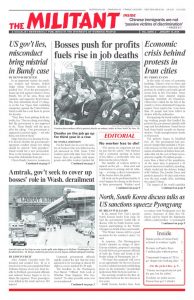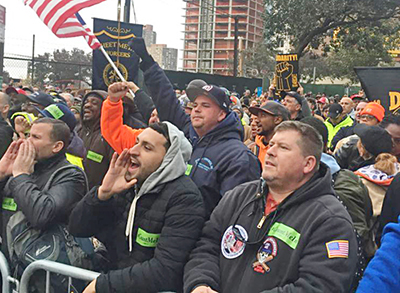For the third year in a row the number of workers who were killed on the job increased in 2016. Some 5,200 workers paid with their lives for the bosses’ drive for profits, with immigrants and older workers hardest hit. This is a 7 percent increase from the year before.
The increase reflects the impact of the employers’ relentless efforts to weaken our unions and toss aside safety protections won in struggle as the bosses fight to compete for market share and garner higher profits.
The 2016 Census of Fatal Occupational Injuries report by the Bureau of Labor Statistics, released Dec. 19, records the highest number of fatalities since 2008, when the financial crisis hit. The report is a stark illustration of the price working people pay for not having fighting unions in face of bosses pitting workers against each other, pressing speedup and long workdays, downsizing workforces and cutting corners on safety.
The highest number of fatalities — some 40 percent — involves work in transportation, such as truck and delivery crashes, and train derailments. Second is violence at work, including homicides and suicides, which rose substantially in 2016. Deaths from drug overdoses also increased. Deaths in construction continue to climb. Workers 65 years and over run about three times as high a risk of being killed on the job as those who are 20 years younger.
The employers ongoing anti-union drive means that today only 6.4 percent of workers in the private sector belong to unions. In addition, there are some 11 million undocumented immigrants forced into jobs with lower wages and less or no health coverage, benefits and pensions. Bosses exploit their situation, pushing them into ever more dangerous jobs and hazardous working conditions.
Construction has one of the highest fatality rates. Workers lose their lives for lack of the most elementary safety precautions, like guardrails and safety harnesses and nets.
Construction in New York used to be overwhelmingly union labor, but over the last few decades this has changed. Today union construction in New York is down to 30 percent. Of the 16 workers who were killed here in 2015, 14 were nonunion, 14 were Latinos.
The picture for 2016 is similar. In February, 62-year-old Konstantinos Potamousis fell six stories to his death. He didn’t have a safety harness. In September, Bruno Travalja, 52, fell more than 40 floors. He was wearing a harness but it wasn’t attached to anything. In December, Wilfredo Enriques, 59, and just about to retire, died in a two-story fall from scaffolding. They all worked on nonunion sites, and were three of the more than 20 workers who died working construction in New York in 2016.
Even though the coal bosses have shuttered mines under competition with foreign employers and falling demand, miners’ deaths surged in the U.S. in 2017. Fifteen coal miners died on the job last year, eight in West Virginia — where the number of union mines has plummeted. In 2016 there were eight U.S. coal mine deaths. West Virginia has seen the most miners’ deaths in six of the last eight years.
Oil and chemical refineries remain some of the most dangerous places for workers, who face suffocating leaks, fires, explosions and falls. And the dangers workers face also threaten those who live in surrounding communities.
More and more oil bosses are seeking to cut costs and push out union workers by calling in contract labor. A 31-year-old woman working on contract construction was killed at ExxonMobil’s Beaumont, Texas, refinery Dec. 1. The company proudly told the press that production wasn’t affected.
Another contract worker was killed when he fell while working on scaffolding at Valero Energy’s Corpus Christi refinery Oct. 4.


